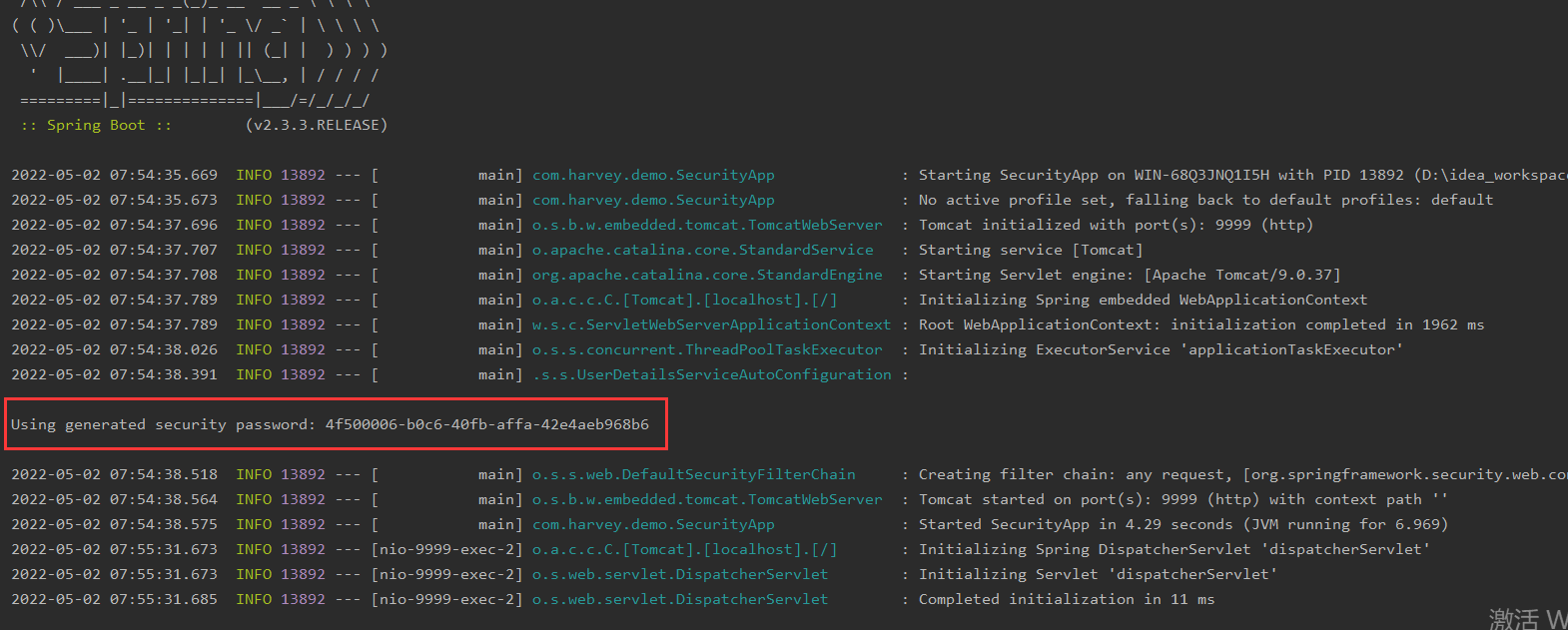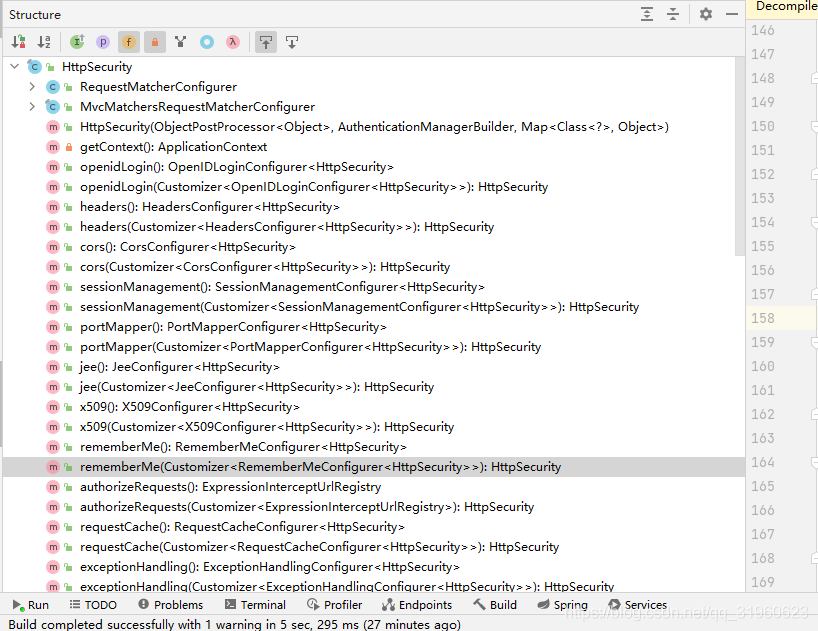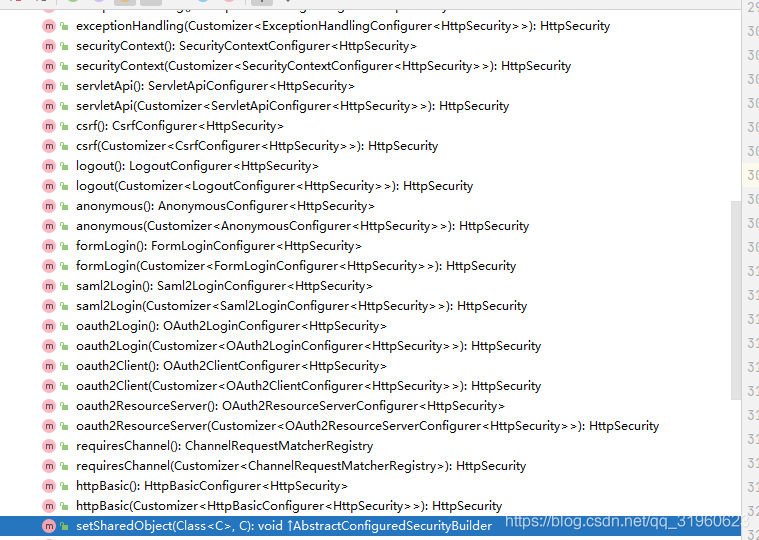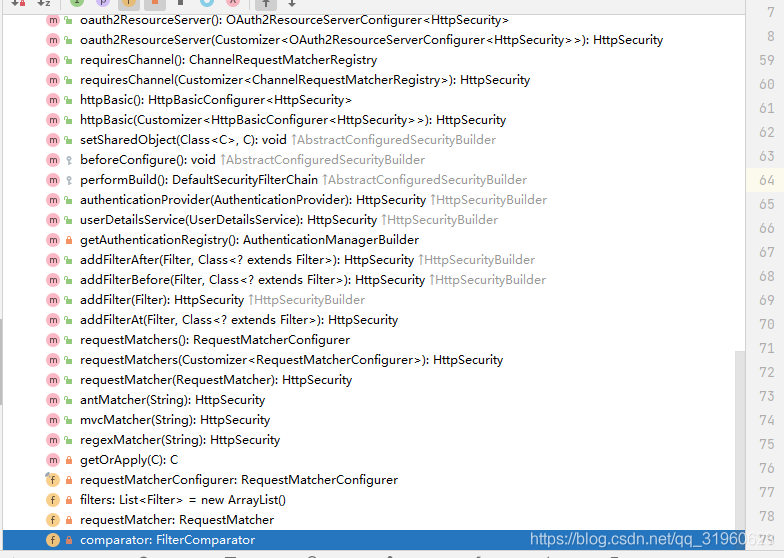SpringBoot集成Spring Security
Spring Security介绍
Spring Security是一个功能强大且高度可定制的身份验证和访问控制框架。提供了完善的认证机制和方法级的授权功能。是一款非常优秀的权限管理框架。它的核心是一组过滤器链,不同的功能经由不同的过滤器。
spring security使用目的:验证,授权,攻击防护。
原理:创建大量的filter和interceptor来进行请求的验证和拦截,以此来达到安全的效果。
大家可以先了解下Spring Security:
- Spring Security原理分析【1】——整体布局切入
- Spring Security原理分析【2】——SecurityFilterChain的构建
- SpringSecurity 原理解析【3】——认证与授权
- SpringSecurity 原理解析【4】——令牌还原与Session
- SpringSecurity 原理解析【5】——Spring Security核心组件
SpringBoot集成Spring Security
基本用法
创建一个springboot项目,添加一个/helloController
@RestController
public class HelloController {
@RequestMapping("/hello")
public String hello(){
return "hello";
}
}这样,这个/hello是可以默认访问,返回一个hello字符串。
添加spring security
向pom.xml中添加security依赖
<dependency>
<groupId>org.springframework.boot</groupId>
<artifactId>spring-boot-starter-security</artifactId>
</dependency>这样在启动的时候会在控制台显示随机生成的密码。

这时访问http://localhost:9999/hello会重定向到http://localhost:9999/login,这个页面是spring默认的。

登陆
1、使用默认用户和随机生成的密码登录
spring security 默认的用户名是user,spring security启动的时候会生成默认密码(在启动日志中可以看到)。
我们填入user 和 上图显示的随机密码,那么就会正常的访问/hello。
2、使用yaml文件定义的用户名、密码登录
在application.yaml中定义用户名密码:
spring:
security:
user:
name: root
password: root使用root/root登录,可以正常访问/hello。
3、使用代码中指定的用户名、密码登录
- 使用configure(AuthenticationManagerBuilder) 添加认证。
- 使用configure(httpSecurity) 添加权限
@Configuration
public class MySecurityConfiguration extends WebSecurityConfigurerAdapter {
@Override
protected void configure(AuthenticationManagerBuilder auth) throws Exception {
auth.inMemoryAuthentication()
.withUser("admin") // 添加用户admin
.password("{noop}admin") // 不设置密码加密
.roles("ADMIN", "USER")// 添加角色为admin,user
.and()
.withUser("user") // 添加用户user
.password("{noop}user")
.roles("USER")
.and()
.withUser("tmp") // 添加用户tmp
.password("{noop}tmp")
.roles(); // 没有角色
}
@Override
protected void configure(HttpSecurity http) throws Exception {
http.authorizeRequests()
.antMatchers("/product/**").hasRole("USER") //添加/product/** 下的所有请求只能由user角色才能访问
.antMatchers("/admin/**").hasRole("ADMIN") //添加/admin/** 下的所有请求只能由admin角色才能访问
.anyRequest().authenticated() // 没有定义的请求,所有的角色都可以访问(tmp也可以)。
.and()
.formLogin().and()
.httpBasic();
}
}添加AdminController、ProductController
@RestController
@RequestMapping("/admin")
public class AdminController {
@RequestMapping("/hello")
public String hello(){
return "admin hello";
}
}@RestController
@RequestMapping("/product")
public class ProductController {
@RequestMapping("/hello")
public String hello(){
return "product hello";
}
}通过上面的设置,访问http://localhost:9999/admin/hello只能由admin访问,http://localhost:9999/product/hello admin和user都可以访问,http://localhost:9999/hello 所有用户(包括tmp)都可以访问。
4、使用数据库的用户名、密码登录
1)添加依赖
<!-- JDBC -->
<dependency>
<groupId>org.springframework.boot</groupId>
<artifactId>spring-boot-starter-jdbc</artifactId>
</dependency>
<!-- MySQL 驱动包-->
<!--MySQL Server 版本为 8.x时,mysql-connector-java使用5.1.35时会报错-->
<dependency>
<groupId>mysql</groupId>
<artifactId>mysql-connector-java</artifactId>
<version>8.0.11</version>
</dependency>2)添加数据库配置
spring:
datasource:
#通用配置
driver-class-name: com.mysql.jdbc.Driver
password: root
username: root
url: jdbc:mysql://localhost:3306/demo?serverTimezone=Asia/Shanghai&useUnicode=true&charcterEncoding=UTF-8&useSSL=false
#数据源连接池配置
hikari:
minimum-idle: 10
maximum-pool-size: 20
idle-timeout: 500000
max-lifetime: 540000
connection-timeout: 60000
connection-test-query: select 13)配置spring-security认证和授权
@Configuration
public class MySecurityConfiguration extends WebSecurityConfigurerAdapter {
@Autowired
private UserDetailsService userDetailsService;
@Override
protected void configure(AuthenticationManagerBuilder auth) throws Exception {
auth.userDetailsService(userDetailsService)// 设置自定义的userDetailsService
.passwordEncoder(passwordEncoder());
}
@Override
protected void configure(HttpSecurity http) throws Exception {
http.authorizeRequests()
.antMatchers("/product/**").hasRole("USER")
.antMatchers("/admin/**").hasRole("ADMIN")
.anyRequest().authenticated() //
.and()
.formLogin()
.and()
.httpBasic()
.and().logout().logoutUrl("/logout");
}
@Bean
public PasswordEncoder passwordEncoder() {
return NoOpPasswordEncoder.getInstance();// 使用不使用加密算法保持密码
//return new BCryptPasswordEncoder();
}
}如果需要使用BCryptPasswordEncoder,可以先在测试环境中加密后放到数据库中:
@Test
public void encode() {
BCryptPasswordEncoder bCryptPasswordEncoder = new BCryptPasswordEncoder();
String password = bCryptPasswordEncoder.encode("user");
String password2 = bCryptPasswordEncoder.encode("admin");
System.out.println(password);
System.out.println(password2);
}4)配置自定义UserDetailsService来进行验证
@Component("userDetailsService")
public class CustomUserDetailsService implements UserDetailsService {
@Autowired
private UserDao userDao;
@Override
public UserDetails loadUserByUsername(String login) throws UsernameNotFoundException {
// 1. 查询用户
User userFromDatabase = userDao.findOneByLogin(login);
if (userFromDatabase == null) {
//log.warn("User: {} not found", login);
throw new UsernameNotFoundException("User " + login + " was not found in db");
//这里找不到必须抛异常
}
// 2. 设置角色
Collection<GrantedAuthority> grantedAuthorities = new ArrayList<>();
GrantedAuthority grantedAuthority = new SimpleGrantedAuthority(userFromDatabase.getRole());
grantedAuthorities.add(grantedAuthority);
return new org.springframework.security.core.userdetails.User(login,
userFromDatabase.getPassword(), grantedAuthorities);
}
}5)数据库查询UserDao
接口:
public interface UserDao {
User findOneByLogin(String login);
}实现类:
@Repository
public class UserDaoImpl implements UserDao {
@Autowired
private JdbcTemplate jdbcTemplate;
@Override
public User findOneByLogin(String login) {
return jdbcTemplate.queryForObject("select * from user where login = ?",
new BeanPropertyRowMapper<User>(User.class), new Object[]{login});
}
}6)添加数据库数据

CREATE TABLE `user` (
`id` int(28) NOT NULL,
`login` varchar(255) COLLATE utf8mb4_general_ci DEFAULT NULL,
`password` varchar(255) COLLATE utf8mb4_general_ci DEFAULT NULL,
`role` varchar(255) COLLATE utf8mb4_general_ci DEFAULT NULL,
PRIMARY KEY (`id`)
) ENGINE=InnoDB DEFAULT CHARSET=utf8mb4 COLLATE=utf8mb4_general_ci;
INSERT INTO `demo`.`user`(`id`, `login`, `password`, `role`) VALUES (1, 'user', 'user', 'ROLE_USER');
INSERT INTO `demo`.`user`(`id`, `login`, `password`, `role`) VALUES (2, 'admin', 'admin', 'ROLE_ADMIN');默认角色前缀必须是ROLE_,因为spring-security会在授权的时候自动使用match中的角色加上ROLE_后进行比较。
7)测试验证
访问 http://localhost:9999/admin/hello 或 http://localhost:9999/product/hello 都会要求输入登陆用户名和密码。
注:当登陆/admin/hello后,如果要想登陆/product/hello,需要先请求/logout退出,再登陆。
8)获取登陆信息
@RequestMapping("/info")
public String info(){
String userDetails = null;
Object principal = SecurityContextHolder.getContext().getAuthentication().getPrincipal();
if(principal instanceof UserDetails) {
userDetails = ((UserDetails)principal).getUsername();
}else {
userDetails = principal.toString();
}
return userDetails;
}spring security session 无状态支持权限控制(前后分离)
spring security会在默认的情况下将认证信息放到HttpSession中。
但是对于我们的前后端分离的情况,如app,小程序,web前后分离等,httpSession就没有用武之地了。这时我们可以通过configure(httpSecurity)设置spring security是否使用httpSession。
@Configuration
public class MySecurityConfiguration extends WebSecurityConfigurerAdapter {
// code...
@Override
protected void configure(HttpSecurity http) throws Exception {
http
.sessionManagement()
//设置无状态,所有的值如下所示。
.sessionCreationPolicy(SessionCreationPolicy.STATELESS)
// code...
}
// code...
}共有四种值,其中默认的是ifRequired。
- always:总是创建HttpSession
- ifRequired:在需要时创建一个HttpSession
- never:不会创建HttpSession,但如果它已经存在,将可以使用HttpSession
- stateless:永远不会创建HttpSession,它不会使用HttpSession来获取SecurityContext
由于前后端不通过保存session和cookie来进行判断,所以为了保证spring security能够记录登录状态,所以需要传递一个值,让这个值能够自我验证来源,同时能够得到数据信息。选型我们选择JWT。对于java客户端我们选择使用jjwt。
添加相关依赖
<!-- jwt -->
<dependency>
<groupId>io.jsonwebtoken</groupId>
<artifactId>jjwt-api</artifactId>
<version>0.11.2</version>
</dependency>
<dependency>
<groupId>io.jsonwebtoken</groupId>
<artifactId>jjwt-impl</artifactId>
<version>0.11.2</version>
<scope>runtime</scope>
</dependency>
<dependency>
<groupId>io.jsonwebtoken</groupId>
<artifactId>jjwt-jackson</artifactId>
<version>0.11.2</version>
<scope>runtime</scope>
</dependency>创建工具类JWTProvider
JWTProvider需要至少提供两个方法,一个用来创建我们的token,另一个根据token获取Authentication。
provider需要保证Key密钥是唯一的,使用init()构建,否则会抛出异常。
@Component
public class JWTProvider {
private Key key; // 私钥
private long tokenValidityInMilliseconds; // 有效时间
private long tokenValidityInMillisecondsForRememberMe; // 记住我有效时间
@Autowired
private JJWTProperties jjwtProperties; // jwt配置参数
@Autowired
private UserDao userDao;
@PostConstruct
public void init() {
byte[] keyBytes;
String secret = jjwtProperties.getSecret();
if (StringUtils.hasText(secret)) {
System.out.println("Warning: the JWT key used is not Base64-encoded. " +
"We recommend using the `jhipster.security.authentication.jwt.base64-secret` key for optimum security.");
keyBytes = secret.getBytes(StandardCharsets.UTF_8);
} else {
System.out.println("Using a Base64-encoded JWT secret key");
keyBytes = Decoders.BASE64.decode(jjwtProperties.getBase64Secret());
}
this.key = Keys.hmacShaKeyFor(keyBytes); // 使用mac-sha算法的密钥
this.tokenValidityInMilliseconds =
1000 * jjwtProperties.getTokenValidityInSeconds();
this.tokenValidityInMillisecondsForRememberMe =
1000 * jjwtProperties.getTokenValidityInSecondsForRememberMe();
}
public String createToken(Authentication authentication, boolean rememberMe) {
long now = (new Date()).getTime();
Date validity;
if (rememberMe) {
validity = new Date(now + this.tokenValidityInMillisecondsForRememberMe);
} else {
validity = new Date(now + this.tokenValidityInMilliseconds);
}
User user = userDao.findOneByLogin(authentication.getName());
Map<String, Object> map = new HashMap<>();
map.put("sub", authentication.getName());
map.put("user", user);
return Jwts.builder()
.setClaims(map) // 添加body
.signWith(key, SignatureAlgorithm.HS512) // 指定摘要算法
.setExpiration(validity) // 设置有效时间
.compact();
}
public Authentication getAuthentication(String token) {
Claims claims = Jwts.parserBuilder()
.setSigningKey(key)
.build()
.parseClaimsJws(token).getBody(); // 根据token获取body
User principal;
Collection<? extends GrantedAuthority> authorities;
principal = userDao.findOneByLogin(claims.getSubject());
authorities = principal.getAuthorities();
return new UsernamePasswordAuthenticationToken(principal, token, authorities);
}
}1)application.yml中添加jwt的配置
# jwt配置
jwt:
# secret 必须足够长
# 否则 The specified key byte array is 40 bits which is not secure enough for any JWT HMAC-SHA algorithm
secret: 777@#12!123~%123456000##1112345111
# base64加密后的secret
base64Secret: Nzc3QCMxMiExMjN+JTEyMzQ1NjAwMCMjMTExMjM0NTExMQ==
# 有效时间(秒)
tokenValidityInSeconds: 1800
# 记住我有效时间(秒)
tokenValidityInSecondsForRememberMe: 18002)JJWTProperties.java
@Component
@ConfigurationProperties(prefix = "jwt")
public class JJWTProperties {
private String secret;
private String base64Secret;
private Long tokenValidityInSeconds;
private Long tokenValidityInSecondsForRememberMe;
public String getSecret() {
return secret;
}
public void setSecret(String secret) {
this.secret = secret;
}
public String getBase64Secret() {
return base64Secret;
}
public void setBase64Secret(String base64Secret) {
this.base64Secret = base64Secret;
}
public Long getTokenValidityInSeconds() {
return tokenValidityInSeconds;
}
public void setTokenValidityInSeconds(Long tokenValidityInSeconds) {
this.tokenValidityInSeconds = tokenValidityInSeconds;
}
public Long getTokenValidityInSecondsForRememberMe() {
return tokenValidityInSecondsForRememberMe;
}
public void setTokenValidityInSecondsForRememberMe(Long tokenValidityInSecondsForRememberMe) {
this.tokenValidityInSecondsForRememberMe = tokenValidityInSecondsForRememberMe;
}
}3)注意:这里我们创建的User需要实现UserDetails对象,这样我们可以根据principal.getAuthorities()获取到权限,如果不实现UserDetails,那么需要自定义authorities并添加到UsernamePasswordAuthenticationToken中。
public class User implements UserDetails {
private Integer id;
private String login;
private String password;
private String role;
public Integer getId() {
return id;
}
public void setId(Integer id) {
this.id = id;
}
public String getLogin() {
return login;
}
public void setLogin(String login) {
this.login = login;
}
public String getPassword() {
return password;
}
public void setPassword(String password) {
this.password = password;
}
public String getRole() {
return role;
}
public void setRole(String role) {
this.role = role;
}
//-------------------- 以下方法是实现UserDetails接口必须重写的方法
@Override
// 获取权限,这里就用简单的方法
// 在spring security中,Authorities既可以是ROLE也可以是Authorities
public Collection<? extends GrantedAuthority> getAuthorities() {
return Collections.singleton(new SimpleGrantedAuthority(role));
}
@Override
public String getUsername() {
return login;
}
@Override
public boolean isAccountNonExpired() {
return true;
}
@Override
public boolean isAccountNonLocked() {
return false;
}
@Override
public boolean isCredentialsNonExpired() {
return true;
}
@Override
public boolean isEnabled() {
return true;
}
}创建登录成功,登出成功处理器
认证成功,返回jwt:
@Component
public class MyAuthenticationSuccessHandler implements AuthenticationSuccessHandler {
@Autowired
private JWTProvider jwtProvider;
@Override
public void onAuthenticationSuccess(HttpServletRequest servletRequest, HttpServletResponse servletResponse, Authentication authentication) throws IOException, ServletException {
PrintWriter writer = servletResponse.getWriter();
writer.println(jwtProvider.createToken(authentication, true));
}
}登出成功:
@Component
public class MyLogoutSuccessHandler implements LogoutSuccessHandler {
@Override
public void onLogoutSuccess(HttpServletRequest servletRequest, HttpServletResponse servletResponse, Authentication authentication) throws IOException, ServletException {
PrintWriter writer = servletResponse.getWriter();
writer.println("logout success");
writer.flush();
}
}设置登录、登出、取消csrf防护
登出无法对token进行失效操作,可以使用数据库保存token,然后在登出时删除该token。
@Configuration
public class MySecurityConfiguration extends WebSecurityConfigurerAdapter {
@Autowired
private MyAuthenticationSuccessHandler authenticationSuccessHandler;
@Autowired
public MyLogoutSuccessHandler logoutSuccessHandler;
@Override
protected void configure(HttpSecurity http) throws Exception {
// 添加登录处理器
http.formLogin()
.loginProcessingUrl("/login")
.successHandler(authenticationSuccessHandler)
.and().csrf().disable(); //取消csrf防护
// 添加登出处理器
http.logout()
.logoutUrl("/logout")
.logoutSuccessHandler(logoutSuccessHandler);
}
}使用JWT集成spring-security
- 添加Filter供spring-security解析token,并向securityContext中添加我们的用户信息。
- 在UsernamePasswordAuthenticationFilter.class之前我们需要执行根据token添加authentication。关键方法是从jwt中获取authentication,然后添加到securityContext中。
- 在SecurityConfiguration中需要设置Filter添加的位置。
1、创建自定义Filter,用于jwt获取authentication:
public class JWTFilter extends GenericFilterBean {
private final static String HEADER_AUTH_NAME = "auth";
private JWTProvider jwtProvider;
public JWTFilter(JWTProvider jwtProvider) {
this.jwtProvider = jwtProvider;
}
@Override
public void doFilter(ServletRequest servletRequest, ServletResponse servletResponse, FilterChain filterChain) throws IOException, ServletException {
try {
HttpServletRequest httpServletRequest = (HttpServletRequest) servletRequest;
String authToken = httpServletRequest.getHeader(HEADER_AUTH_NAME);
if (StringUtils.hasText(authToken)) {
// 从自定义tokenProvider中解析用户
Authentication authentication = this.jwtProvider.getAuthentication(authToken);
SecurityContextHolder.getContext().setAuthentication(authentication);
}
// 调用后续的Filter,如果上面的代码逻辑未能复原“session”,SecurityContext中没有想过信息,后面的流程会检测出"需要登录"
filterChain.doFilter(servletRequest, servletResponse);
} catch (Exception ex) {
throw new RuntimeException(ex);
}
}
}2、向HttpSecurity添加Filter和设置Filter位置:
public class MySecurityConfiguration extends WebSecurityConfigurerAdapter {
// code...
@Override
protected void configure(HttpSecurity http) throws Exception {
http
.sessionManagement()
//设置添加Filter和位置
.and().addFilterBefore(new JWTFilter(jwtProvider), UsernamePasswordAuthenticationFilter.class);
// code...
}
// code...
}3、MySecurityConfiguration代码:
@Configuration
public class MySecurityConfiguration extends WebSecurityConfigurerAdapter {
@Autowired
private MyLogoutSuccessHandler logoutSuccessHandler;
@Autowired
public MyAuthenticationSuccessHandler authenticationSuccessHandler;
@Autowired
private UserDetailsService userDetailsService;
@Autowired
private JWTProvider jwtProvider;
@Override
protected void configure(AuthenticationManagerBuilder auth) throws Exception {
auth.userDetailsService(userDetailsService)// 设置自定义的userDetailsService
.passwordEncoder(passwordEncoder());
}
@Override
protected void configure(HttpSecurity http) throws Exception {
http
.sessionManagement()
.sessionCreationPolicy(SessionCreationPolicy.STATELESS)//设置无状态
.and()
.authorizeRequests() // 配置请求权限
.antMatchers("/product/**").hasRole("USER") // 需要角色
.antMatchers("/admin/**").hasRole("ADMIN")
.anyRequest().authenticated() // 所有的请求都需要登录
.and()
// 配置登录url,和登录成功处理器
.formLogin().loginProcessingUrl("/login").successHandler(authenticationSuccessHandler)
// 取消csrf防护
.and().csrf().disable()
.httpBasic()
// 配置登出url,和登出成功处理器
.and().logout().logoutUrl("/logout")
.logoutSuccessHandler(logoutSuccessHandler)
// 在UsernamePasswordAuthenticationFilter之前执行我们添加的JWTFilter
.and().addFilterBefore(new JWTFilter(jwtProvider), UsernamePasswordAuthenticationFilter.class);
}
@Bean
public PasswordEncoder passwordEncoder() {
return NoOpPasswordEncoder.getInstance();
}
@Override
public void configure(WebSecurity web) {
// 添加不做权限的URL
web.ignoring()
.antMatchers("/swagger-resources/**")
.antMatchers("/swagger-ui.html")
.antMatchers("/webjars/**")
.antMatchers("/v2/**")
.antMatchers("/h2-console/**");
}
}4、使用注解对方法进行权限管理
需要在MySecurityConfiguration上添加@EnableGlobalMethodSecurity(prePostEnabled = true)注解,prePostEnabled默认为false,需要设置为true后才能全局的注解权限控制。
prePostEnabled设置为true后,可以使用四个注解:
添加实体类School:
public class School implements Serializable {
private Long id;
private String name;
private String address;
}1)@PreAuthorize
在访问之前就进行权限判断
@RestController
public class AnnoController {
@Autowired
private JWTProvider jwtProvider;
@RequestMapping("/annotation")
//@PreAuthorize("hasRole('ADMIN')")
@PreAuthorize("hasAuthority('ROLE_ADMIN')")
public String info(){
return "拥有admin权限";
}
}hasRole和hasAuthority都会对UserDetails中的getAuthorities进行判断区别是hasRole会对字段加上ROLE_后再进行判断,上例中使用了hasRole('ADMIN'),那么就会使用ROLE_ADMIN进行判断,如果是hasAuthority('ADMIN'),那么就使用ADMIN进行判断。
2)@PostAuthorize
在请求之后进行判断,如果返回值不满足条件,会抛出异常,但是方法本身是已经执行过了的。
@RequestMapping("/postAuthorize")
@PreAuthorize("hasRole('ADMIN')")
@PostAuthorize("returnObject.id%2==0")
public School postAuthorize(Long id) {
School school = new School();
school.setId(id);
return school;
}returnObject是内置对象,引用的是方法的返回值。
如果returnObject.id%2==0为 true,那么返回方法值。如果为false,会返回403 Forbidden。
3)@PreFilter
在方法执行之前,用于过滤集合中的值。
@RequestMapping("/preFilter")
@PreAuthorize("hasRole('ADMIN')")
@PreFilter("filterObject%2==0")
public List<Long> preFilter(@RequestParam("ids") List<Long> ids) {
return ids;
}filterObject是内置对象,引用的是集合中的泛型类,如果有多个集合,需要指定filterTarget。
@PreFilter(filterTarget="ids", value="filterObject%2==0")
public List<Long> preFilter(@RequestParam("ids") List<Long> ids,@RequestParam("ids") List<User> users,) {
return ids;
}filterObject%2==0会对集合中的值会进行过滤,为true的值会保留。
第一个例子返回的值在执行前过滤返回2,4。
4)@PostFilter
会对返回的集合进行过滤。
@RequestMapping("/postFilter")
@PreAuthorize("hasRole('ADMIN')")
@PostFilter("filterObject.id%2==0")
public List<School> postFilter() {
List<School> schools = new ArrayList<School>();
School school;
for (int i = 0; i < 10; i++) {
school = new School();
school.setId((long)i);
schools.add(school);
}
return schools;
}上面的方法返回结果为:id为0,2,4,6,8的School对象。
Spring Security API
HttpSecurity
下面是HttpSecurity中的所有方法



常用的方法说明
1)openidLogin()
用于基于 OpenId 的验证
2)headers()
将安全标头添加到响应
3)cors()
配置跨域资源共享( CORS )
4)sessionManagement()
允许配置会话管理
5)portMapper()
允许配置一个PortMapper(HttpSecurity#(getSharedObject(class))),其他提供SecurityConfigurer的对象使用 PortMapper 从 HTTP 重定向到 HTTPS 或者从 HTTPS 重定向到 HTTP。默认情况下,Spring Security使用一个PortMapperImpl映射 HTTP 端口8080到 HTTPS 端口8443,HTTP 端口80到 HTTPS 端口443。
6)jee()
配置基于容器的预认证。 在这种情况下,认证由Servlet容器管理
7)x509()
配置基于x509的认证
8)rememberMe
允许配置“记住我”的验证
9)authorizeRequests()
允许基于使用HttpServletRequest限制访问
10)requestCache()
允许配置请求缓存
11)exceptionHandling()
允许配置错误处理
12)securityContext()
在HttpServletRequests之间的SecurityContextHolder上设置SecurityContext的管理。 当使用WebSecurityConfigurerAdapter时,这将自动应用。
13)servletApi()
将HttpServletRequest方法与在其上找到的值集成到SecurityContext中。 当使用WebSecurityConfigurerAdapter时,这将自动应用。
14)csrf()
添加 CSRF 支持,使用WebSecurityConfigurerAdapter时,默认启用
15)logout()
添加退出登录支持。当使用WebSecurityConfigurerAdapter时,这将自动应用。默认情况是,访问URL”/ logout”,使HTTP Session无效来清除用户,清除已配置的任何#rememberMe()身份验证,清除SecurityContextHolder,然后重定向到”/login?success”
16)anonymous()
允许配置匿名用户的表示方法。 当与WebSecurityConfigurerAdapter结合使用时,这将自动应用。 默认情况下,匿名用户将使用org.springframework.security.authentication.AnonymousAuthenticationToken表示,并包含角色 “ROLE_ANONYMOUS”
17)formLogin()
指定支持基于表单的身份验证。如果未指定FormLoginConfigurer#loginPage(String),则将生成默认登录页面
18)oauth2Login()
根据外部OAuth 2.0或OpenID Connect 1.0提供程序配置身份验证
19)requiresChannel()
配置通道安全。为了使该配置有用,必须提供至少一个到所需信道的映射
20)httpBasic()
配置 Http Basic 验证
21)addFilterAt()
在指定的Filter类的位置添加过滤器
更详细的介绍:HttpSecurity 详解
HttpSecurity示例
登录注销配置
@Configuration
public class SecurityConfig extends WebSecurityConfigurerAdapter {
@Override
protected void configure(HttpSecurity http) throws Exception {
http.authorizeRequests()
.formLogin()
// 登录处理接口
.loginProcessingUrl("/login")
// 定义登录页面,未登录时,访问一个需要登录之后才能访问的接口,会自动跳转到该页面
.loginPage("/login")
// 定义登录时,用户名的 key,默认为 username
.usernameParameter("uname")
// 定义登录时,用户密码的 key,默认为 password
.passwordParameter("passwd")
// 登录成功的处理器
.successHandler(new AuthenticationSuccessHandler() {
@Override
public void onAuthenticationSuccess(HttpServletRequest httpServletRequest, HttpServletResponse httpServletResponse, Authentication authentication) throws IOException, ServletException {
httpServletResponse.setContentType("application/json;charset=utf-8");
PrintWriter out = httpServletResponse.getWriter();
Map<String, Object> map = new HashMap<>();
map.put("status", 200);
map.put("msg", authentication.getPrincipal());
out.write(new ObjectMapper().writeValueAsString(map));
out.flush();
out.close();
}
})
// 登录失败的处理器
.failureHandler(new AuthenticationFailureHandler() {
@Override
public void onAuthenticationFailure(HttpServletRequest httpServletRequest, HttpServletResponse httpServletResponse, AuthenticationException e) throws IOException, ServletException {
httpServletResponse.setContentType("application/json;charset=utf-8");
PrintWriter out = httpServletResponse.getWriter();
Map<String, Object> map = new HashMap<>();
map.put("status", 401);
if (e instanceof LockedException) {
map.put("msg", "账户被锁定,登录失败!");
} else if (e instanceof BadCredentialsException) {
map.put("msg", "用户名或密码输入错误,登录失败!");
} else if (e instanceof DisabledException) {
map.put("msg", "账户被禁用,登录失败!");
} else if (e instanceof AccountExpiredException) {
map.put("msg", "账户过期,登录失败!");
} else if (e instanceof CredentialsExpiredException) {
map.put("msg", "密码过期,登录失败!");
} else {
map.put("msg", "登录失败!");
}
out.write(new ObjectMapper().writeValueAsString(map));
out.flush();
out.close();
}
})
// 和表单登录相关的接口统统都直接通过
.permitAll()
.and()
.logout()
.logoutUrl("/logout")
// 注销成功的处理器
.logoutSuccessHandler(new LogoutSuccessHandler() {
@Override
public void onLogoutSuccess(HttpServletRequest httpServletRequest, HttpServletResponse httpServletResponse, Authentication authentication) throws IOException, ServletException {
httpServletResponse.setContentType("application/json;charset=utf-8");
PrintWriter out = httpServletResponse.getWriter();
Map<String, Object> map = new HashMap<>();
map.put("status", 200);
map.put("msg", "注销登录成功!");
out.write(new ObjectMapper().writeValueAsString(map));
out.flush();
out.close();
}
});
}
}

